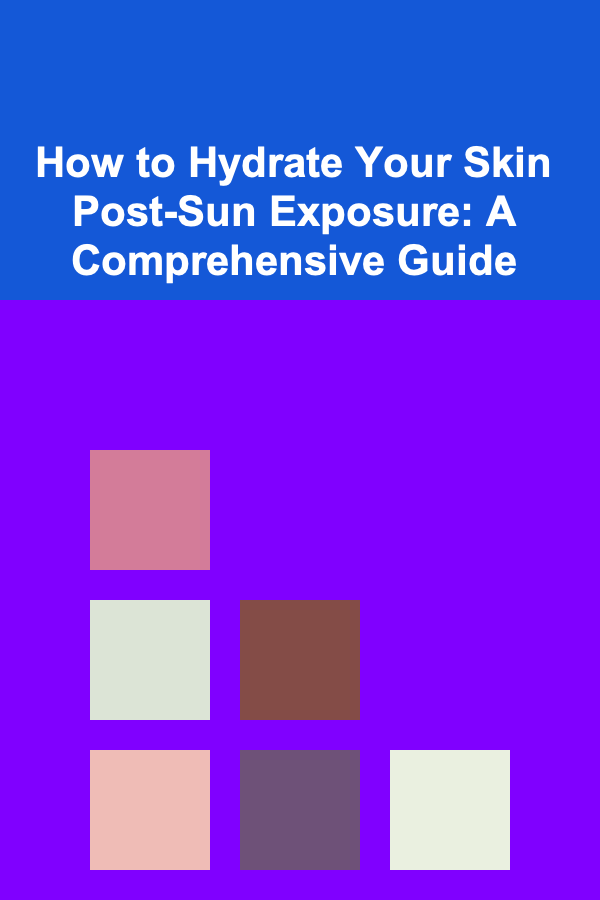
How to Hydrate Your Skin Post-Sun Exposure: A Comprehensive Guide
ebook include PDF & Audio bundle (Micro Guide)
$12.99$8.99
Limited Time Offer! Order within the next:

Spending time outdoors, especially in sunny weather, can be a joy. However, prolonged sun exposure can wreak havoc on your skin, leading to dehydration, sunburn, premature aging, and even an increased risk of skin cancer. Understanding how to properly hydrate your skin after sun exposure is crucial for maintaining its health, elasticity, and youthful appearance. This comprehensive guide will delve into the science behind sun-induced dehydration, explore various methods for rehydration, and provide practical tips to keep your skin healthy and radiant.
Understanding the Impact of Sun Exposure on Skin Hydration
Before diving into hydration techniques, it's important to understand how the sun damages and dehydrates the skin. Ultraviolet (UV) radiation, specifically UVA and UVB rays, are the primary culprits.
- UVB Rays: These rays are responsible for sunburns. They damage the outer layers of the skin (epidermis), causing inflammation, redness, and pain. This damage disrupts the skin's natural barrier function, leading to increased water loss.
- UVA Rays: These rays penetrate deeper into the skin (dermis), causing damage to collagen and elastin fibers. Collagen and elastin are essential proteins that provide structure and elasticity to the skin. UVA damage leads to premature aging, wrinkles, and a loss of firmness. They also generate free radicals, unstable molecules that attack healthy cells, further exacerbating dehydration and damage.
When skin is exposed to the sun, the following processes occur:
- Increased Water Loss (Transepidermal Water Loss - TEWL): The damaged skin barrier allows water to evaporate more easily from the deeper layers of the skin, leading to dehydration.
- Inflammation: Sunburn causes inflammation, which further disrupts the skin's barrier function and increases TEWL. Inflamed skin also requires more water to heal and repair itself.
- Damage to Lipids: UV radiation damages the lipids (fats) that make up the skin's protective barrier. These lipids are crucial for retaining moisture and preventing dehydration.
- Free Radical Production: As mentioned earlier, UV radiation generates free radicals, which attack collagen, elastin, and other essential skin components. This damage contributes to dehydration and premature aging.
The visible signs of sun-induced dehydration include:
- Dryness and flakiness
- Tightness and discomfort
- Redness and irritation
- Increased sensitivity to touch
- Fine lines and wrinkles appearing more prominent
- Dullness and lack of radiance
Immediate Steps to Take After Sun Exposure
Taking prompt action after sun exposure is crucial to minimize damage and begin the rehydration process. Here's a step-by-step guide:
1. Cool Down Immediately
The first priority is to cool down the skin. This helps to reduce inflammation and discomfort.
- Cool Shower or Bath: Take a cool (not cold) shower or bath. Avoid using harsh soaps or scrubbing, as this can further irritate the skin. Gently pat your skin dry with a soft towel.
- Cool Compress: Apply a cool compress (a damp cloth) to the affected areas for 10-15 minutes at a time. You can repeat this several times a day.
2. Rehydrate Internally
Hydrating from the inside out is just as important as topical hydration. The body needs water to repair damaged tissues and maintain optimal function.
- Drink Plenty of Water: Drink plenty of water to replenish lost fluids. Aim for at least 8-10 glasses of water per day.
- Electrolyte Drinks: Consider drinking electrolyte-rich beverages like sports drinks or coconut water. These drinks help to replenish lost electrolytes, which are essential for hydration and overall health.
- Water-Rich Foods: Consume water-rich fruits and vegetables like watermelon, cucumbers, strawberries, and spinach. These foods not only provide hydration but also offer essential vitamins and antioxidants.
3. Assess the Damage
Carefully examine your skin to assess the extent of the sun damage. Look for signs of sunburn, redness, blistering, or inflammation. This assessment will help you determine the appropriate course of treatment.
Topical Hydration Strategies: Choosing the Right Products
After cooling down and rehydrating internally, it's time to focus on topical hydration. Choosing the right products is crucial for restoring the skin's moisture barrier and promoting healing.
1. Gentle Cleansing
Avoid harsh soaps and cleansers that can strip the skin of its natural oils. Opt for a gentle, fragrance-free cleanser that is specifically designed for sensitive skin.
- Cream Cleansers: These cleansers are typically mild and hydrating, making them ideal for dry or sunburned skin.
- Oil Cleansers: Oil cleansers can effectively remove dirt and impurities without stripping the skin of its natural oils.
- Micellar Water: Micellar water is a gentle cleansing solution that can be used to remove makeup and dirt without the need for rinsing.
Avoid using exfoliating scrubs or products containing harsh chemicals, as these can further irritate the skin.
2. Hydrating Serums
Serums are lightweight, concentrated formulas that penetrate deeply into the skin to deliver potent ingredients. Look for serums containing the following hydrating ingredients:
- Hyaluronic Acid: Hyaluronic acid is a powerful humectant, meaning it attracts and retains moisture from the air. It can hold up to 1000 times its weight in water, making it an excellent ingredient for hydrating dry and dehydrated skin.
- Glycerin: Glycerin is another humectant that helps to draw moisture into the skin. It also has emollient properties, meaning it helps to soften and smooth the skin.
- Aloe Vera: Aloe vera is known for its soothing and anti-inflammatory properties. It can help to relieve sunburn and reduce redness. It also contains polysaccharides, which help to hydrate and protect the skin.
- Panthenol (Vitamin B5): Panthenol is a humectant and emollient that helps to hydrate and soothe the skin. It also has wound-healing properties, making it beneficial for repairing sun-damaged skin.
Apply the serum to clean, damp skin to maximize its absorption.
3. Moisturizers
Moisturizers are essential for creating a protective barrier on the skin's surface, preventing water loss and keeping the skin hydrated. Choose a moisturizer that is appropriate for your skin type and the severity of the sun damage.
- Emollients: Emollients are ingredients that help to soften and smooth the skin. Examples include shea butter, cocoa butter, and jojoba oil.
- Occlusives: Occlusives form a protective barrier on the skin's surface, preventing water loss. Examples include petrolatum, beeswax, and mineral oil.
- Humectants: As mentioned earlier, humectants attract and retain moisture from the air. Examples include hyaluronic acid, glycerin, and honey.
For severely sunburned skin, a thicker, more occlusive moisturizer may be necessary to prevent water loss and promote healing. For milder cases of dehydration, a lighter, more hydrating moisturizer may suffice.
Look for moisturizers that are fragrance-free, paraben-free, and non-comedogenic (meaning they won't clog pores).
4. Soothing Masks
Facial masks can provide an extra boost of hydration and soothing relief for sun-exposed skin. Look for masks containing ingredients like:
- Aloe Vera: As mentioned earlier, aloe vera is known for its soothing and anti-inflammatory properties.
- Cucumber: Cucumber is cooling and hydrating, making it a great ingredient for soothing sunburned skin.
- Oatmeal: Oatmeal has anti-inflammatory and soothing properties. It can help to relieve itching and irritation caused by sunburn.
- Honey: Honey is a natural humectant and has antibacterial properties. It can help to hydrate and heal the skin.
Apply the mask to clean skin and leave it on for the recommended time (usually 10-15 minutes). Rinse thoroughly with cool water and follow with a moisturizer.
5. Topical Corticosteroids (For Severe Sunburns)
In cases of severe sunburn with significant inflammation and blistering, a topical corticosteroid cream may be necessary to reduce inflammation and promote healing. These creams should only be used under the guidance of a dermatologist or healthcare provider. They are usually applied sparingly to the affected areas and used for a limited period of time.
Important Note: Prolonged use of topical corticosteroids can have side effects, so it's essential to follow your doctor's instructions carefully.
Specific Ingredients to Look For and Avoid
Navigating the world of skincare ingredients can be overwhelming. Here's a quick guide to ingredients to look for and avoid when hydrating sun-exposed skin:
Ingredients to Look For:
- Hyaluronic Acid: A powerful humectant that attracts and retains moisture.
- Glycerin: Another humectant with emollient properties.
- Aloe Vera: Soothing, anti-inflammatory, and hydrating.
- Panthenol (Vitamin B5): Humectant, emollient, and wound-healing properties.
- Ceramides: Lipids that help to restore the skin's protective barrier.
- Shea Butter: An emollient that softens and smooths the skin.
- Jojoba Oil: An emollient that mimics the skin's natural oils.
- Green Tea Extract: An antioxidant that protects against free radical damage.
- Vitamin E: An antioxidant that protects against free radical damage and helps to moisturize the skin.
Ingredients to Avoid:
- Alcohol: Can dry out the skin and exacerbate dehydration.
- Fragrances: Can irritate sensitive skin and cause allergic reactions.
- Parabens: Preservatives that may disrupt hormone function.
- Sulfates (SLS/SLES): Harsh surfactants that can strip the skin of its natural oils.
- Exfoliating Acids (AHAs/BHAs): While beneficial for exfoliation, they can further irritate sunburned skin. Avoid using them until the skin has healed.
- Retinoids: Similar to exfoliating acids, retinoids can irritate sunburned skin. Avoid using them until the skin has healed.
Long-Term Hydration Strategies and Prevention
Hydrating your skin after sun exposure is important, but preventing sun damage in the first place is even more crucial. Here are some long-term strategies for maintaining skin health and preventing future sun-induced dehydration:
1. Consistent Sunscreen Use
Sunscreen is the single most important tool for protecting your skin from the sun's harmful rays. Apply a broad-spectrum sunscreen with an SPF of 30 or higher every day, even on cloudy days. Broad-spectrum sunscreens protect against both UVA and UVB rays.
- Apply Liberally: Use at least one ounce (about a shot glass full) of sunscreen to cover your entire body.
- Reapply Frequently: Reapply sunscreen every two hours, or more often if you are swimming or sweating.
- Choose the Right Sunscreen: Consider using a mineral sunscreen containing zinc oxide or titanium dioxide, as these are generally considered to be safer and more effective than chemical sunscreens.
2. Protective Clothing
Wear protective clothing to shield your skin from the sun's rays. This includes:
- Long Sleeves and Pants: Opt for long-sleeved shirts and pants made from tightly woven fabrics.
- Wide-Brimmed Hats: Wear a wide-brimmed hat to protect your face, ears, and neck.
- Sunglasses: Wear sunglasses that block 100% of UVA and UVB rays to protect your eyes and the delicate skin around them.
3. Seek Shade
Seek shade whenever possible, especially during peak sun hours (typically between 10 am and 4 pm). Trees, umbrellas, and buildings can provide shade and help to reduce your sun exposure.
4. Consistent Skincare Routine
Establish a consistent skincare routine that includes gentle cleansing, hydrating serums, and moisturizers. This will help to keep your skin healthy and hydrated, even when exposed to the sun.
5. Healthy Diet and Lifestyle
A healthy diet and lifestyle can also contribute to skin health. Eating plenty of fruits, vegetables, and healthy fats provides the nutrients your skin needs to stay hydrated and protected. Avoid smoking and excessive alcohol consumption, as these can dehydrate the skin and contribute to premature aging.
6. Stay Hydrated Internally
Continue to drink plenty of water throughout the day to keep your skin hydrated from the inside out.
When to Seek Medical Attention
While most cases of sunburn and sun-induced dehydration can be managed at home, there are certain situations that require medical attention. Seek medical care if you experience any of the following:
- Severe blistering covering a large area of the body
- Fever or chills
- Nausea or vomiting
- Dizziness or confusion
- Signs of dehydration, such as decreased urination, dry mouth, and rapid heartbeat
- Severe pain that is not relieved by over-the-counter pain medication
Conclusion
Hydrating your skin after sun exposure is essential for maintaining its health, elasticity, and youthful appearance. By understanding the impact of sun damage, taking prompt action after exposure, and choosing the right hydration strategies, you can help to restore your skin's moisture barrier and promote healing. Remember to prioritize prevention by using sunscreen, wearing protective clothing, and seeking shade. By following these tips, you can enjoy the benefits of spending time outdoors while keeping your skin healthy and radiant for years to come.

How to Create Extra Storage Space Under the Stairs
Read More
How to Strengthen Your Home's Entry Points Against Burglars
Read More
How to Use Wall-Mounted Solutions for Craft Supply Storage
Read More
Maximizing Your Commute: Tips for Effectively Utilizing Ride-Sharing Services
Read More
Selecting and Arranging Mirrors: A Comprehensive Guide
Read More
Mastering Pinterest Marketing for Print-on-Demand (POD)
Read MoreOther Products

How to Create Extra Storage Space Under the Stairs
Read More
How to Strengthen Your Home's Entry Points Against Burglars
Read More
How to Use Wall-Mounted Solutions for Craft Supply Storage
Read More
Maximizing Your Commute: Tips for Effectively Utilizing Ride-Sharing Services
Read More
Selecting and Arranging Mirrors: A Comprehensive Guide
Read More